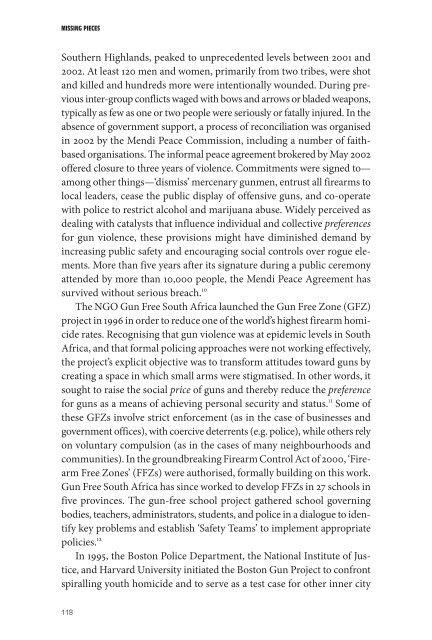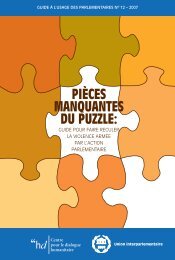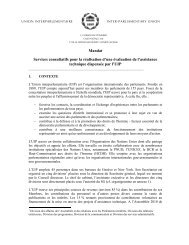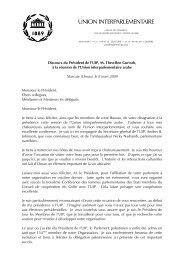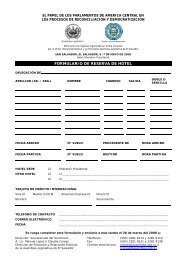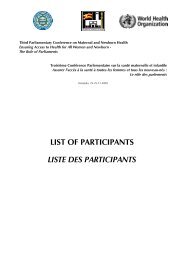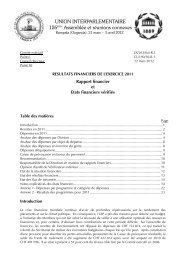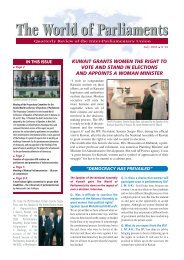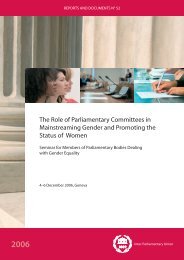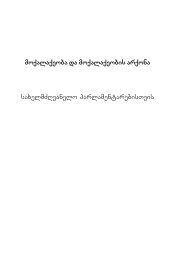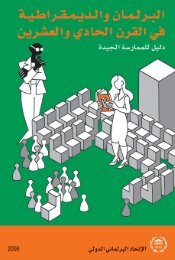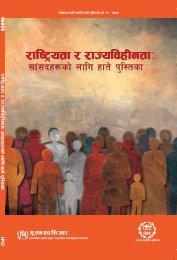MISSING PIECES - Inter-Parliamentary Union
MISSING PIECES - Inter-Parliamentary Union
MISSING PIECES - Inter-Parliamentary Union
You also want an ePaper? Increase the reach of your titles
YUMPU automatically turns print PDFs into web optimized ePapers that Google loves.
<strong>MISSING</strong> <strong>PIECES</strong><br />
Southern Highlands, peaked to unprecedented levels between 2001 and<br />
2002. At least 120 men and women, primarily from two tribes, were shot<br />
and killed and hundreds more were intentionally wounded. During previous<br />
inter-group conflicts waged with bows and arrows or bladed weapons,<br />
typically as few as one or two people were seriously or fatally injured. In the<br />
absence of government support, a process of reconciliation was organised<br />
in 2002 by the Mendi Peace Commission, including a number of faithbased<br />
organisations. The informal peace agreement brokered by May 2002<br />
offered closure to three years of violence. Commitments were signed to—<br />
among other things—‘dismiss’ mercenary gunmen, entrust all firearms to<br />
local leaders, cease the public display of offensive guns, and co-operate<br />
with police to restrict alcohol and marijuana abuse. Widely perceived as<br />
dealing with catalysts that influence individual and collective preferences<br />
for gun violence, these provisions might have diminished demand by<br />
increasing public safety and encouraging social controls over rogue elements.<br />
More than five years after its signature during a public ceremony<br />
attended by more than 10,000 people, the Mendi Peace Agreement has<br />
survived without serious breach. 10<br />
The NGO Gun Free South Africa launched the Gun Free Zone (GFZ)<br />
project in 1996 in order to reduce one of the world’s highest firearm homicide<br />
rates. Recognising that gun violence was at epidemic levels in South<br />
Africa, and that formal policing approaches were not working effectively,<br />
the project’s explicit objective was to transform attitudes toward guns by<br />
creating a space in which small arms were stigmatised. In other words, it<br />
sought to raise the social price of guns and thereby reduce the preference<br />
for guns as a means of achieving personal security and status. 11 Some of<br />
these GFZs involve strict enforcement (as in the case of businesses and<br />
government offices), with coercive deterrents (e.g. police), while others rely<br />
on voluntary compulsion (as in the cases of many neighbourhoods and<br />
communities). In the groundbreaking Firearm Control Act of 2000, ‘Firearm<br />
Free Zones’ (FFZs) were authorised, formally building on this work.<br />
Gun Free South Africa has since worked to develop FFZs in 27 schools in<br />
five provinces. The gun-free school project gathered school governing<br />
bodies, teachers, administrators, students, and police in a dialogue to identify<br />
key problems and establish ‘Safety Teams’ to implement appropriate<br />
policies. 12<br />
In 1995, the Boston Police Department, the National Institute of Justice,<br />
and Harvard University initiated the Boston Gun Project to confront<br />
spiralling youth homicide and to serve as a test case for other inner city<br />
118


